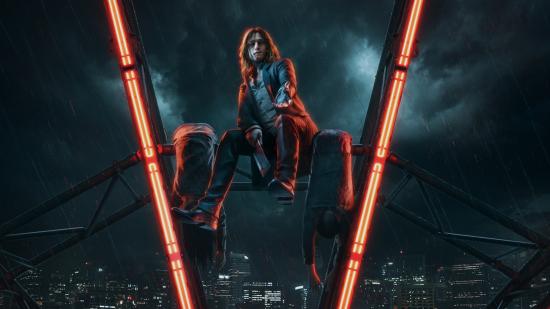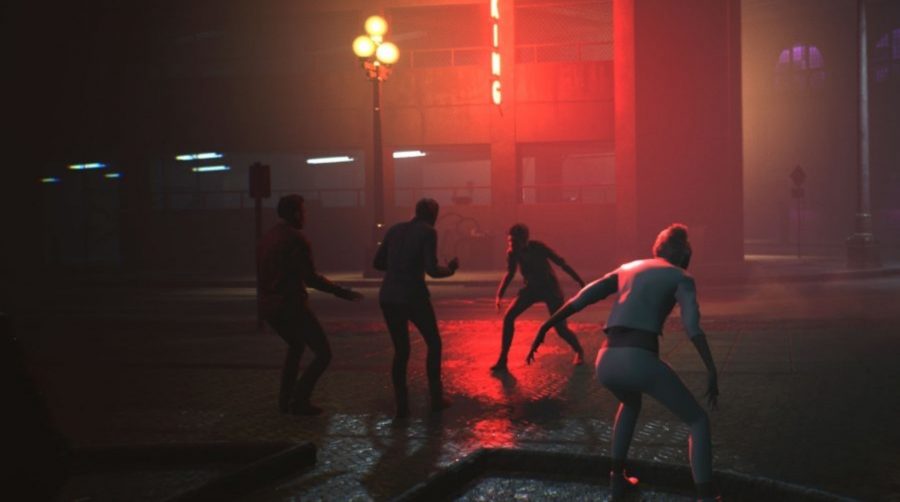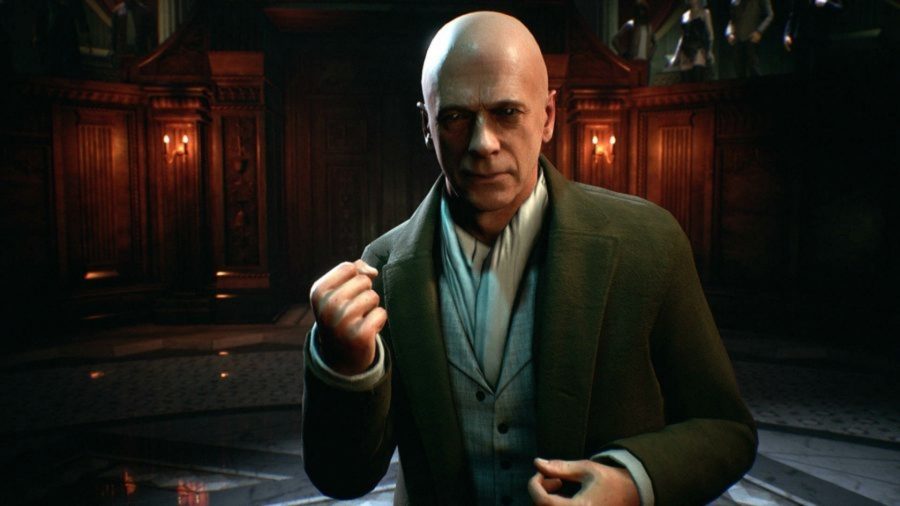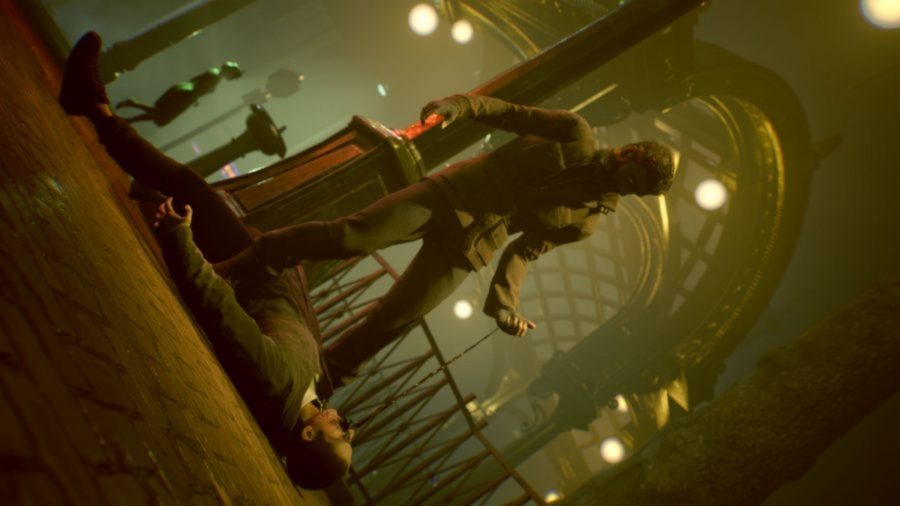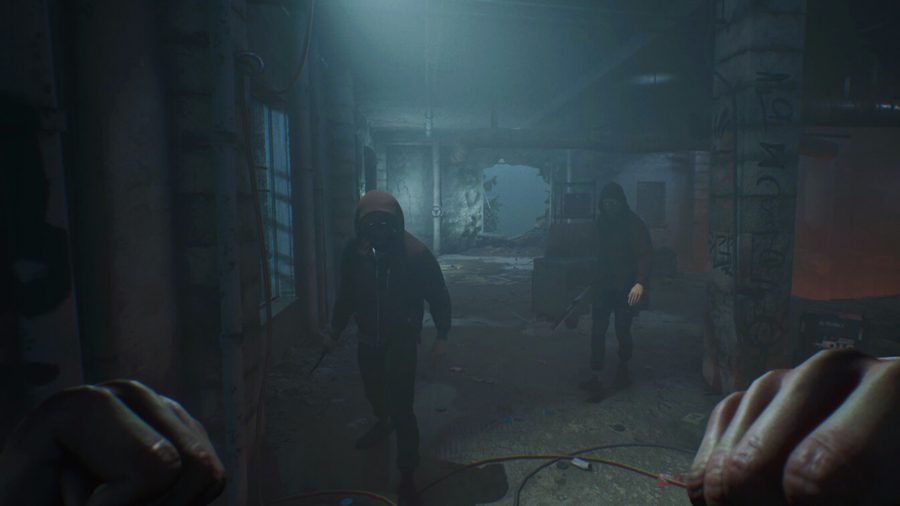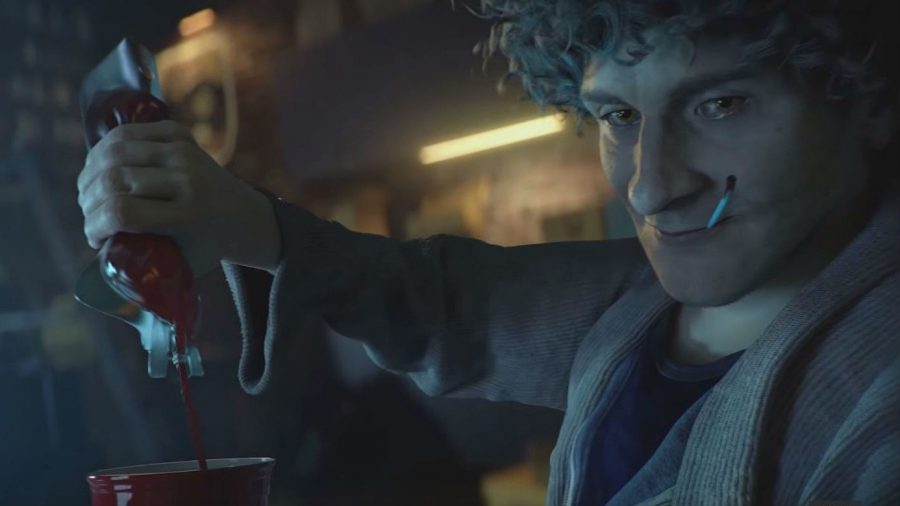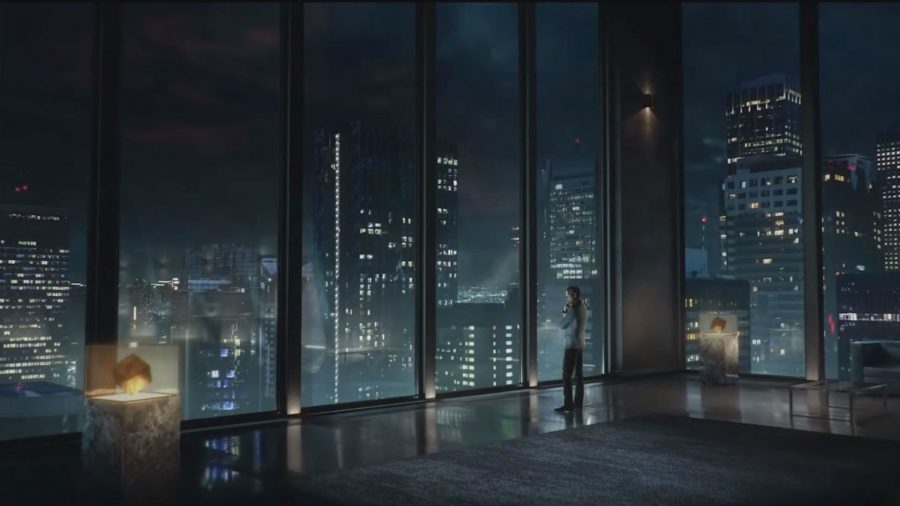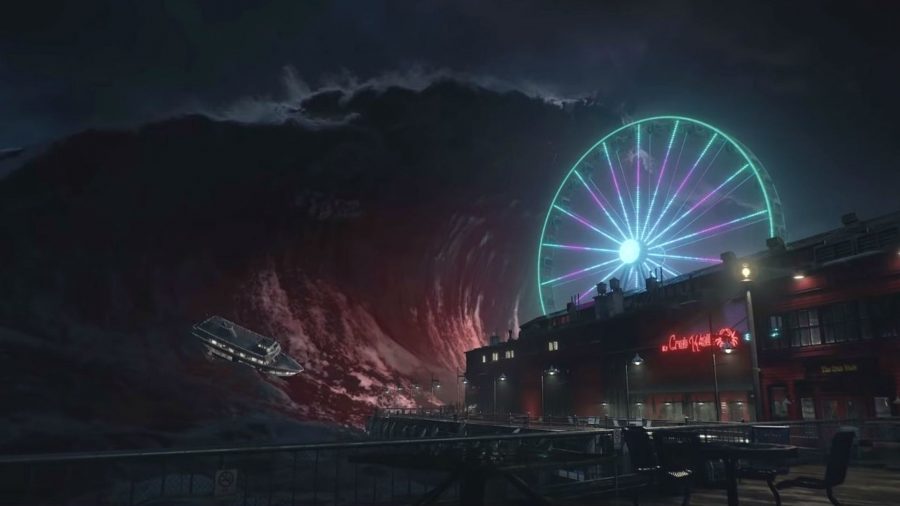After Paradox teased the new Vampire: The Masquerade sequel with a twitter thread full of moody, nighttime cityscapes it left fans hungry for more information about the studio’s new addition to the vampiric RPG series.
Vampire: The Masquerade – Bloodlines 1 let you slip into the character of a fledgling vampire, skulking around the streets of an alternate-reality version of LA filled with demons, werewolves, and the undead. The game was also buoyed by the fact that it released back in 2004, when vampires were still sexy, cool, and not afraid of flaunting a bit of black eyeliner. Bloodlines 2 looks to have followed in its predecessors footsteps and taken inspiration from other immersive sims, sprinkling Deus Ex and Dishonored into its grisly bloodbath.
On the prowl for more info to replenish our Bloodlines thirst, we hunted down a whole host of people from Paradox and Hardsuit Labs including, art director Luke Dodge, UX/UI designer Rachel Leiker, Paradox’s senior product manager Florian Schwarzer, Producer Nikhat Ali, and Hardsuit Labs’ creative director Ka’ai Cluney. Capitalising on their collective insight, we asked about Bloodlines 2’s new setting, what features are being carried over from the old game, and where the immersive sim genre is heading.
PCGN: Why did you decide to go with Seattle as the location for Bloodlines 2?
Ka’ai Cluney: In late 2015, I saw that Paradox had acquired the World of Darkness IP. For a long time I’ve been friends with Brian Mitsoda, who was the writer on the original. So, maybe a little recklessly, I texted Brian and asked him if he would be interested in putting together a pitch. He said, ‘Okay’. Well, he was a little more excited than that, and probably within the first couple of hours I was at a bar, he was at home, and we were texting back and forth.
It probably took us about half an hour to come up with Seattle, and then maybe an hour and a half to come up with the major conflicts. Then it all went from there. That weekend, I went over to Brian’s house, drank a bunch of whiskey, and came up with basically the core plot of the game. Well Brian did, I just drank.
Seattle made sense for a lot of reasons. For one thing, there’s the old-versus-new aspect, and it goes a lot deeper than that. Possibly because we’re pretty familiar with it, [Seattle] embodies a lot of the conflicts that are going on right now. There’s a lot of things going on in the world like tradition versus progress.
You have the tech sector and you have a lot of progressive history in Seattle. And there’s all these clashes that are happening in the city that day-to-day people who live in Seattle see every day and they talk about all the time.
It just seemed like the right tone to strike, and also Seattle looks really good at night. It’s a cool-looking city and in the winter when the nights are long, so many things about it came together that just made sense. Once we established the setting, themes, plot points, and stories it just snowballed. Within the first 72 hours there was no other choice but Seattle, and a lot of the actual touchstones of the game just evolved right out of that.
Are there any specific weird histories that Seattle has that could be expanded?
KC: Oh there are so many.
Rachel Leiker: So many.
Any favourites?
KC: The Seattle Underground, for one thing, is a super-interesting story. Some of that stuff we may or may not be getting into depending on whether there’s opportunity. Seattle has a lot of hills, one of those was called Denny Hill – they completely flattened it and basically took all the land. The next one was supposed to be Queen Anne Hill, but all the workers who demolished Denny Hill lived on Queen Anne so they decided not to do that…
Then there’s the I-5 going through Seattle that they basically used as an opportunity to demolish neighbourhoods that they didn’t want around anymore. That kind of stuff just goes all the way back to its founding. It was founded by opportunists and criminals, it’s just so rich.
Anywhere you poke at any point in time over the past hundred years, you’re going to hit something that’s interesting that you could blame on vampire influence if you want to. It’s really cool, there’s just so much depth there.
RL: Seattle is a very underutilised city from our perspective. I’m sure if you asked anybody that you know about Seattle it’s either the Space Needle, Nirvana, or coffee, and that’s pretty much the cultural knowledge of Seattle. But Seattle has way more than that going on. It’s a very weird city, historically, and that gives us a real opportunity to make some really cool stuff.
KC: And it’s not just underutilised – a lot of times it’s misutilised. If a TV show is set in Seattle they’ll do an establishing shot of the Space Needle then they all go to Vancouver and film it there.
RL: [Laughs] Because it’s cheaper there.
In relation to Bloodlines 1’s LA, how big is Seattle in Bloodlines 2?
Florian Schwarzer: In terms of thematic size, Bloodlines painted a portrait of LA and we’re trying to do the same thing with Seattle. We have several areas – one is Pioneer square – that are bigger and allow you to free roam, and show very iconic areas of the city. From there on we go into the more specific, and more gnarly, parts of the city to experience missions or meet other characters.
There are games that shy away from being political, but politics is an important part of Bloodlines. Can games be a forum for these kinds of discussions?
KC: Yes, I think they can. I don’t think you necessarily need to inject politics into every little thing like Tetris or Overwatch. You can if you want, but I think games as a medium are just as capable of discussing topics as any other. I think whether you choose to or not is up to you, but there’s so much potential for storytelling in there that why not use that tool to discuss what it is you want to discuss?
I imagine concerns over alienating potential players – is that something that concerns you?
KC: I mean it depends on who I’m alienating. Can I say more [laughs]?
FS: I think that’s a nice way of putting it. In the end, a good story is a good story, and I will say that we are respectful to what is being talked about. Nobody here was afraid of calling each other out on their shit, so to speak. If you try to do things justice then I don’t think you actually alienate too many people.
Nikhat Ali: I think Brian and Ka’ai are the perfect duo to handle heavy and political topics with respect.
KC: I think if you’re going to tell stories about human beings or vampires as a metaphor for human beings, and there’s going to be a conflict, it’s going to be really difficult to avoid subjects that some people might see as political. Not necessarily marching through the streets with banners or anything, but political statements sometimes just happen when human beings interact with each other.
Bloodlines 2’s atmosphere is thick with dread and mystery. How did you go about establishing that?
Luke Dodge: As Ka’ai was saying earlier, Seattle ended up being a perfect setting for the game. One thing that we’re bringing back is the noir structure, but from a narrative side as well as the visual side. There’s a lot of noir influences for the overall narrative and also in the art direction. It’s a neo-noir art style with some supernatural horror elements layered on top and Seattle ended up being a perfect setting for that. It’s got a lot of character, it can be very moody, it’s got a lot of atmosphere. It rains a lot so we’ve always got a dreary overall feeling. One thing I really want to do is make sure that it wasn’t drab and monotone. That’s one of my favourite things about the neo-noir aesthetic is that it allows us to really infuse a lot of colour into the scene, so our game is quite vibrant but it still can carry the overall mood and tone.
You mentioned that the main character is superhuman. How do you make players feel powerful without breaking the game?
KC: I know I said it before but it was a touchstone for us early on is establishing the core vampire competency. The vampires should feel more like just a person running around with a baseball bat until they do some magic shit. Everything they do down to movement speed, run speed, how we handle the traversal jump height, melee impact, that sort of thing. It all needed to feel powerful, and part of it is staying in first person. You have limited spacial awareness so you do have to pay attention which forces you to move. Forcing you to move through we can balance it with numbers when it comes to humans.
One thing that we don’t see in here a lot is kind of the more supernatural enemies and those we can do a lot more with. One of the early touchstones, not in terms of mechanics or feel or anything, but just in terms of that concept was like the Arkham games from Batman. One of the things when I was playing that was that prior games you walk into a room with 10 or 15 guys and you’re like, ‘Shit okay, I need to think about how to do this’. Those games you walk into a room with 10 or 15 guys and you’re like, ‘I get to kick the shit out of 10 or 15 guys.’ It’s not necessarily the threat it’s how you go about it.
There’s the threat of the mysterious woman, that comes in on the story side as well.
KC: Oh yeah, the story threats are definitely there and prominent from the very beginning. Part of it is just that sense that you don’t necessarily know where you are and that goes into the whole noir thing. It goes back to old detective movies and fiction where the protagonist doesn’t know what’s going on so they’re learning the story as the player is learning the story.
In the original Bloodlines there were times where missions has an emphasis on guns and weapons, how did you approach this in Bloodlines 2?
KC: There will be times where you want to use them, but they won’t be nearly as necessary. Another thing is how we handle progression when using them. If you don’t put points into firearms it doesn’t mean that you’re not going to hit what you’re aiming at, it doesn’t mean that you’re not going to be competent with a gun it just means that you don’t have as many options.
What were the biggest things you wanted to address from the original?
KC: We really started it with what the first one did well, what we felt we could do, and – to be perfectly honest – we could do it because we just cheated [laughs]. If you want to do what the first one does well, which is character, story, mood, and nailing the setting, you get the person who did it right the first time – that’s Brian. That was the easy part, just ‘Hey Brian, go be Brian.’
As far as the other stuff went, it was really helpful for us to be able to establish early on that the rules of Vampire as they are in the tabletop are different than the rules in the video game. The important thing is the setting, the important thing is the moon, and the important thing is, given the various disciplines and abilities and skills and all that, how to translate increasing competence in a video game without being tied to how increasing competence is handled in the tabletop. So being able to divorce that freed us up to basically make a video game and then layer an RPG on top.
Choice was a big thing in first game – has that aspect been expanded in anyway?
KC: I think it’s just as much of a priority, I know it was a huge priority on the first one. I feel like we’ve spread it out more. Player choice, player reactivity, player agency options, all of that has to tie into every single thing we do. It’s been drilled into the team over the course of development where it’s, ‘what options does this give the player? Does this railroad the player?’
Related: Have you seen Skyrim’s underground city of vampires?
Schwarzer: I do honestly think that the bloodlines formula, if I may use that word, hasn’t actually been imitated successfully that often but yes, there is a big conflict. Some vampires are currently close to being at each other’s throats in the city and how you align yourself will have an impact. But on the other hand, the thing that I think is much more interesting in that game is that you get to have an effect on really, really fascinating people that you along the way in a much more personal way.
Clooney: That was that was such a huge part of the first one, there was the story and setting but the characters are what really mattered. I think the characters are always the touchstone that bring people back to it and a big part of Bloodlines was the effect you could have on those characters. And so we do have entire quest lines that are based on your effect on the characters in the game. That was an important touchstone.
When are you hoping to release the new Bloodline game?
Clooney: Q1 2020
So you can’t commit on whether it be the Epic store or Steam?
Clooney: For those two economically, yes. I’m not going to be defining this right now because there are still a few months between now and then.
What are your reactions to Google Stadia?
FS: May I answer that one with an enthusiastic but not very informative smile please [laughs].
KC: I can honestly say that I know nothing about it because I’ve been in this room the whole time.
When it comes to exploration, there seems less hand holding.
RL: We really wanted to make both the systems, the interactables, and the quest lines in Bloodlines, be player initiated. Both to just help with immersion because it is a role playing game, and also because it’s something that we want players to engage with on a very deep level. Having just an abundance of UI pointing you to different things felt really immersion breaking and not what the Bloodlines experience is about. What was kind of a directive from the very beginning of development was that we want the player to be able to have a full explanation of the areas, the narrative, and everything in between without us having to hold their hands and point them in a direction.
I can see a lot of immersive sims of the past decade reflected in Bloodlines 2. Are there any immersive sims that you’ve been playing?
KC: As many as possible. I think the first Bloodline planted the seeds. I wouldn’t personally call Bloodlines 1 an immersive sim but I think it had a lot of influence on games that progressed in that direction. So I think it makes perfect sense to take some of the lessons learned there and apply them to Bloodlines. I think the direction that we’re consciously moving into is pushing back towards the RPG narrative. The idea is to have a very strong narrative experience as an RPG.
Read more: Check out our list of the best RPGs on PC
FS: From the publishing side that was actually one of the fascinations for me when we started working on Bloodlines. I very much had the same set of lenses when I looked at the game as a player beforehand.
But as more and more people on our side – we have a company full of RPG nerds, but very different RPG nerds – started touching the game you start noticing that – and I’m going to say a horrible business word now – Bloodlines’ DNA can be found in many places.
People who are fans of the classic Bioware RPGs found a lot of things that they love of their preferred games, and same was true for the Bethesda players. I’d say that one of the challenges that I didn’t foresee when I started working on Bloodlines was to make sure everybody had the chance of finding that again.
Co-authored by Harry Shepherd and Rachel Watts
